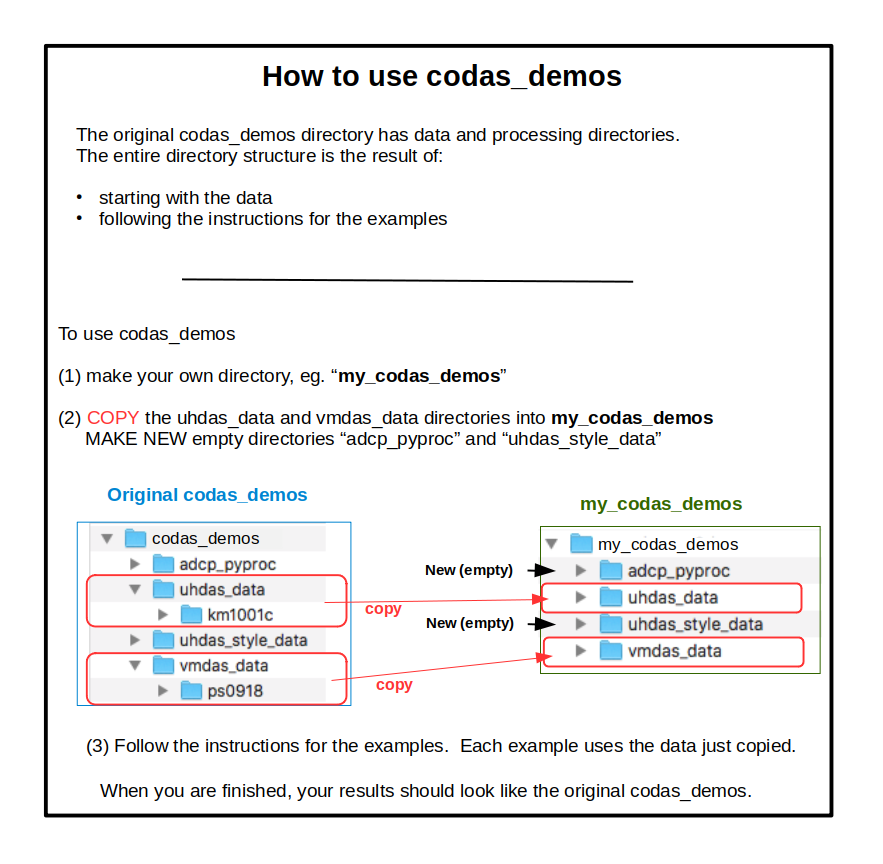2.2. Demos: Overview and Directory Layout¶
2.2.1. Overview¶
The first tutorial demonstrates typical steps post-processing steps for a UHDAS dataset acquired at sea.
Note
You really need to do the postprocessing demo first. Then
it’s relatively easy to go through the steps necessary
for your scenario using adcp_database_maker.py. If for some
reason that doesn’t work, the last set of demos shows you the actual steps
going on behind the scenes, in case you need to do things more manually.
To create the directory used in post-processing two datasets are used: UHDAS and VmDAS. These will be demonstrated using adcp_database_maker.py. Additional demos will show how to obtain the same data results using command-line steps.

The examples that follow use two datasets for practice, one is UHDAS Data and one is VmDAS Data. UHDAS data includes two flavors: the entire raw single-ping data, stored in a directory structure with specific file names; and the pre-processed data from the at-sea UHDAS processing. which contains ocean velocities in earth coordinates. VmDAS also has single-ping data (ENR,N1R,N2R files) and averaged data in earth-coordinates (LTA or STA).
The processing examples that follow use the data from the codas_demos*.zip
files mentioned in the CODAS Installation instructions. Paths given below match the
virtual computer, for simplicity. For example, on the virtual
machine:
the
codas_demossource is in:~/adcpcode/programs/codas_demosthe examples use
~/my_codas_demosto do the demos.
Instructions for each processing example exist in four places:
using adcp_database_maker.py: these
codas_demostutorialsbasic instructions:
quick_adcp.pycommand-line helpannotated instructions: see links in each section
with metadata: the text files associated with the processing (in the
codas_demos/adcp_pyprocdirectories) have the same (basic) instructions, with additional meta-data included. These completed files are a good example of what to submit with your data when you send it in to the Joint Archive for Shipboard ADCP, JASADCP
Note
You should work through the post-processing demo because no matter what kind of data you have (VmDAS or UHDAS) ultimately you will need to know how to do the post-processing.
The demos cover these scenarios:
POSTPROCESSING
postprocessing a dataset collected by UHDAS at sea
VmDAS post-processing demo (referred to in VmDAS LTA demos below)
PRELIMINARY PROCESSING
adcp_database_maker.py
UHDAS data
VmDAS LTA (or STA) data
VmDAS ENR (single-ping) processing
commandline demos
UHDAS data using command-line steps
“vmdas_quick_ltaproc.py” command-line
LTA data using command-line steps
ENR data using command-line steps
There is also a rudimentary “PINGDATA” demo, using the original 1993
pingdata. The “original pingdata demo” has a very detailed manual,
but the manual was written for Matlab processing (so some parts are
different). The new Python pingdata demo exists in the text+directory
form (no html documentation) alongside the other demos, and in
quick_adcp.py --help. There is not a web page for the pingdata demo.
The glossary describes some of the terminology.
This figure describes the demo directory structure and how it ties to the terminology.
This ascii file shows the layout of the demo directory in more detail.
(Return to TOP)
2.2.2. Demos: Directory Setup¶
The codas_demos directory is both an example (of what a final
data processing directory looks like) and the source (of the
data for these examples). If you start with the directory structure
described below, your final processing directory should be nearly
identical to codas_demos/adcp_pyproc.
Before you start working with any of the demos, make your own directory to store the data and practice processing. The examples assume you have already set up a working directory such as below. The command-line examples are designed to copy-paste and use in the virtual computer. A graphical example is shown below.
Check out the glossary for these terms, used below:
make a directory called
my_codas_demosto hold your practice demosexample:
cd
ls
mkdir my_codas_demos
cd my_codas_demos
pwd
The result should be:
/home/adcpproc/my_codas_demos
Copy the uhdas_data directory from the example into
my_codas_demos, just as you would if you were getting the data from an at-sea diskexample:
cd ~/my_codas_demos
cp -a /home/adcpcode/programs/codas_demos/uhdas_data .
ls uhdas_data
The result should be:
km1001c
Copy the vmdas_data directory into
my_codas_demosexample:
cd ~/my_codas_demos
cp -a /home/adcpcode/programs/codas_demos/vmdas_data .
ls vmdas_data
The result should be:
ps0918
Make a directory called uhdas_style_data (for converted VmDAS data)
example:
cd ~/my_codas_demos
mkdir uhdas_style_data
ls
The results should show 3 directories, all related to data:
uhdas_data uhdas_style_data vmdas_data
Make a directory called
adcp_pyproc(for your UHDAS and VmDAS projects)example:
cd ~/my_codas_demos
mkdir adcp_pyproc
cd adcp_pyproc
pwd
The result should be:
/home/adcpproc/my_codas_demos/adcp_pyproc
Make one project directory for each dataset. All your processing examples related to that dataset will be in the associated project directory.
example:
cd ~/my_codas_demos
cd adcp_pyproc
pwd
mkdir km1001c_uhdas
mkdir ps0918_vmdas
ls
The result should show the two project directories:
km1001c_uhdas ps0918_vmdas
These steps are summarized here (copy-paste text suitable for the CODAS virtual computer).
All the examples will refer to adcp_pyproc. You will be building
up your own version, but the directory structure and files of a finished
version exist in your data source for the demo.
Click the image below to enlarge

(Return to TOP)